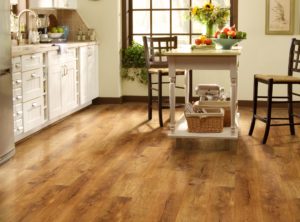Laminate Flooring Pros and Cons

Laminate flooring has been growing in popularity both in Europe and the US in the last several years. To have a quick idea of the success of this relatively new technology, consider that the global market for laminate flooring is expected to reach over 1.9 billion square yards by 2020 (source: Global Industry Analysis, http://www.strategyr.com/pressMCP-1166.asp). The US market is supposed to grow at a rate of 4.5 % per year, reaching 26.8 billion dollars in 2021 from 21.5 billion in 2016.
What is behind the success of laminate flooring? First, it’s cheaper than other common materials like hardwood, stones, marbles and ceramic. For example, a hardwood flooring costs between $8 and $15 per square foot versus $3 to $11 for laminate flooring. Ceramic tile flooring starts from $ 9 minimum and stone flooring costs $7 per square foot on average.
Second, laminate flooring is easy to install and easy to remove. A DIY (do-it-yourself) installation can even be considered normal with this material. Therefore, when you get tired of the design or the color of your laminate floor, you can change it without much hassle. This is not possible with other types of flooring. The installation of ceramic or stone tiles, for example, requires highly specialized workers with mortar and concrete, and days and days of hard work. It’s no wonder that their prices are expensive.
Third, maintenance and cleaning are a real piece of cake with laminate floorings. Usually, it is sufficient just to sweep them. To make a comparison, ceramic tiles requires at least mopping, while stone tiles are easily stainable because of their high porosity.
Last, laminate flooring is more environmentally friendly, as it is almost totally made out of renewable materials that are produced with low CO2 emissions, and there is no utilization of chemical glues in the installation. The disposal of laminate tiles is less complicated than materials like ceramics or stones. Not surprisingly, your laminate flooring can give a real contribution to get a green label like LEED for your house.
And the cons? Naturally, there are also some drawbacks with laminate flooring. Laminate floorings cannot perfectly imitate natural materials in texture and the sensation at the touch. Walking barefoot on a real wooden floor gives you a totally different feeling than walking on its vinyl imitation, while real ceramics conveys a feeling of warmth that is unique.
Another issue with laminate flooring is that they cannot be used in any situation. For example, in an historic house or building this kind of material may be regarded as a violation of the constraints that the city council imposes for the conservation of historic buildings. Being laminate tiles and water natural enemies, laminate tiles cannot be used in wet environments like bathrooms or kitchens. Consider also that laminates could be regarded as definitively not classy by sophisticated people. So, they should be avoided in luxurious mansions or other luxurious contexts.
When to use laminate floorings, so? In my opinion, this technology is great in modern buildings and urban flats/studios, especially for those who need an easy- to-maintain and quick-to-clean floor. In other contexts, like country houses, ancient buildings and luxurious environments, it is better to follow the tradition and opt for wood, ceramics, bricks or stone.
Photo credit: https://shawfloors.com/flooring/laminate
